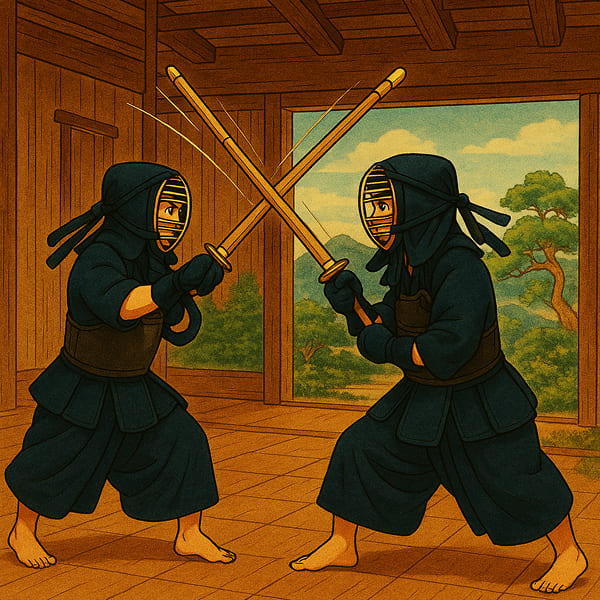Kendo: The Way of the Sword and Spirit in Japanese Martial Arts

Contents
A sharp cry echoes through the dojo.
Bamboo swords clash with precision and force. But behind every strike lies something deeper than combat—an unwavering spirit shaped by centuries of tradition.
This is kendo—“The Way of the Sword”, a time-honored Japanese martial art that fuses intense physical training with the pursuit of mental and spiritual clarity.
Practiced with bamboo swords (shinai) and protective armor (bogu), kendo is more than a sport. It is a path of self-discipline and personal growth. From ancient samurai to modern dojos around the world, kendo continues to inspire those who seek not only strength, but also inner balance and cultural connection.
But where did this powerful tradition begin—and how has it evolved into the form we see today? Let’s explore the origins and journey of kendo.
The Origins and Evolution of Kendo
Kendo originated from kenjutsu, the ancient sword techniques practiced by samurai warriors during Japan’s turbulent Warring States era. As peace settled during the Edo period (1603–1868), bamboo swords and armor were introduced to safely continue training and preserve swordsmanship traditions.
During this time, kendo also began to be seen not just as a combat skill, but as a way to cultivate character and discipline—reflecting the values expected of samurai in a peaceful society.
In the Meiji period (1868–1912), this educational aspect was formalized as kendo was introduced into the school curriculum as a character-building practice. Although martial arts were briefly banned after World War II, kendo was revived in the 1950s and recognized for its educational and cultural value. Today, it thrives both in Japan and in over 50 countries worldwide.
What Makes Kendo Unique?
Kendo emphasizes personal growth as much as physical skill. Key characteristics include:
- Traditional Equipment
Practitioners wear bogu (armor) and use shinai (bamboo swords). The armor includes the men (helmet), do (torso), kote (gloves), and tare (waist protector). - Etiquette and Posture
Each practice begins and ends with a bow, showing respect for one’s opponent and the discipline. Maintaining correct posture and manners is essential throughout. - Kiai and Zanshin
During a strike, practitioners shout the intended target like “Men!” or “Do!”—this kiai expresses fighting spirit. Zanshin, or remaining mindful and composed after a strike, is equally important. - Spiritual Discipline
Consistent training builds mental fortitude, humility, and self-awareness, aligning with the deeper values of Japanese culture.
Kendo Matches and Ranking System
In official kendo matches, a point is awarded only if the strike demonstrates proper technique, precision, and spirit. Valid target areas include:
- Men (head)
- Kote (wrist)
- Do (torso)
- Tsuki (throat, advanced level only)
A panel of three referees decides the validity of each point. Victory typically goes to the first player to score two points. Notably, tsuki is prohibited for junior high school students and younger due to its difficulty and risk.
Kendo uses a structured ranking system starting from kyu levels for beginners to dan levels for advanced practitioners, similar to other Japanese martial arts.
The Modern Value of Practicing Kendo
In today’s fast-paced world, kendo offers more than personal development—it provides a much-needed space for focus, discipline, and inner calm.
For many, especially younger generations and working professionals, the ritual and rhythm of training act as a counterbalance to daily stress and digital overload.
Kendo has also become a bridge between cultures. International tournaments, exchange programs, and global dojos allow practitioners around the world to engage not only with martial arts, but also with Japanese values like respect, perseverance, and harmony.
Whether practiced as a lifelong path or a temporary discipline, kendo continues to offer modern people something rare: a chance to train the mind, not just the body, and to connect across generations and cultures through shared spirit and form.
Conclusion: The Way of the Sword in Modern Life
Kendo is more than a martial art—it is a living tradition that sharpens not only the sword, but also the spirit.
Rooted in the discipline of the samurai and shaped by generations of practice, it continues to guide modern practitioners toward focus, resilience, and respect.
Whether practiced in a quiet dojo in Japan or on polished floors halfway across the world, kendo offers something timeless:
a way to confront ourselves, to grow through challenge, and to find connection in form, rhythm, and spirit.
In every bow, every shout, every strike—the Way of the Sword lives on.